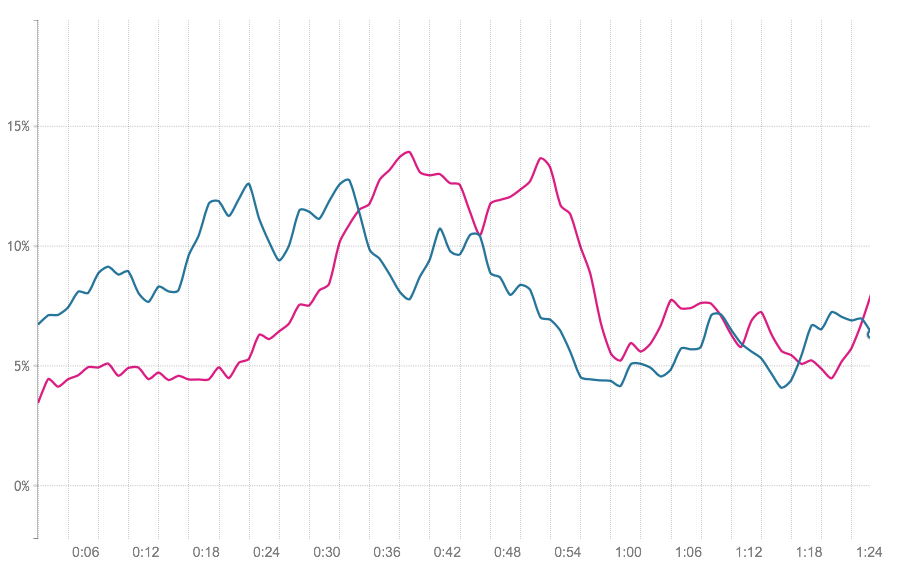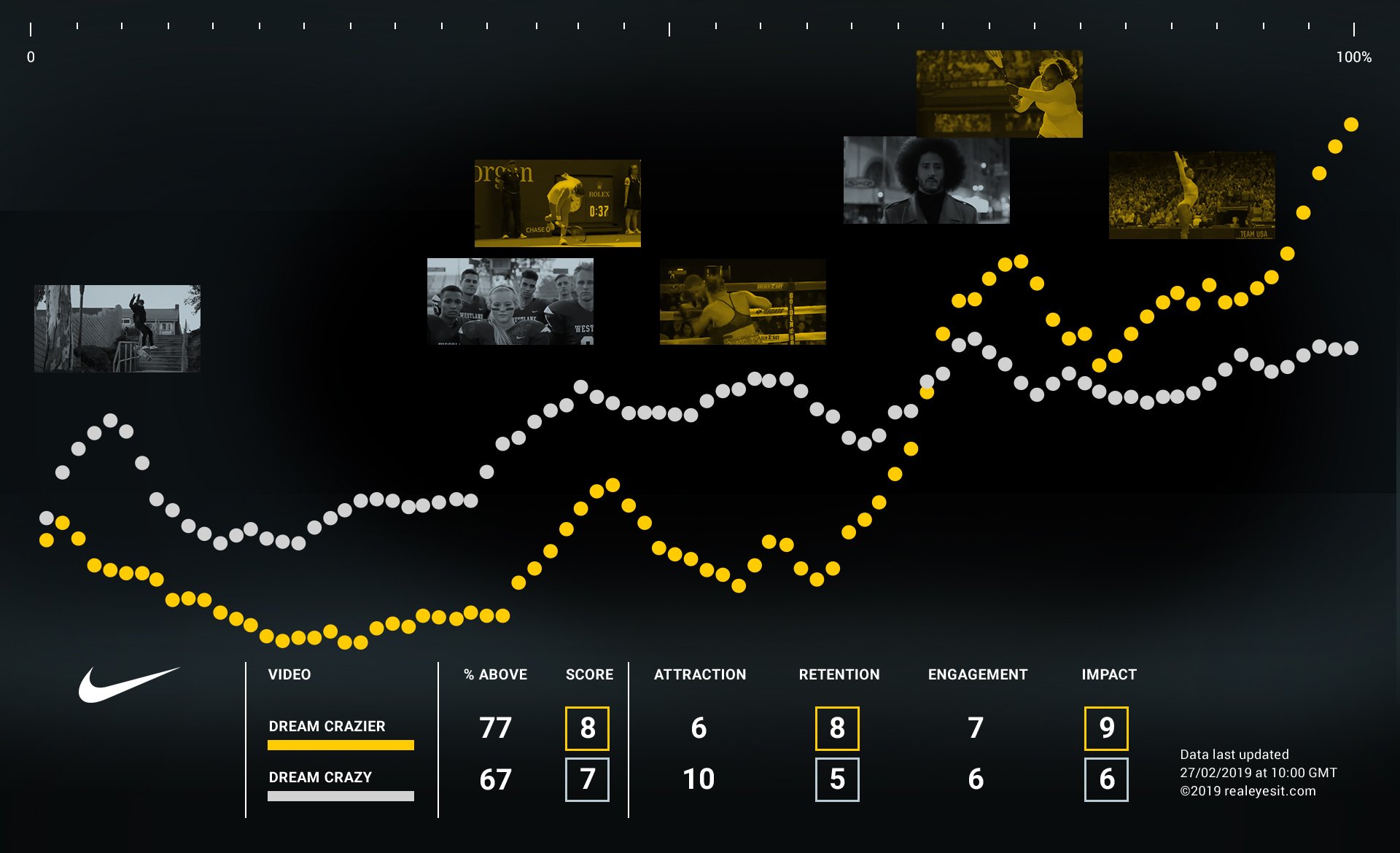
Nike's Serena Williams Ad More Engaging Than Colin Kaepernick Spot

Colin Pye
Nike hit the headlines in September 2018 with its “Dream Crazy” ad, featuring controversial NFL star Colin Kaepernick.
Kaepernick is a polarising figure in the US, having attracted a lot of criticism (and support) when he decided to kneel during the American national anthem to protest police brutality towards the black community. The bold move led to outrage across Twitter and a rebuke from US President Donald Trump, but also an increase in sales for the sports brand.So it was no surprise that Nike has since released a follow-up, called “Dream Crazier”, this time narrated by another controversial sport star, Serena Williams. It also features other leading female sport stars, such as gymnast Simone Biles, snowboarder Chloe Kim and fencer Ibtihaj Muhammad, among others. Launched ahead of this summer’s Women’s World Cup, the ad tackles gender inequality in sport, highlighting the way female sports stars are portrayed in the media.
As Serena says: “If we show emotion, we’re called dramatic. If we want to play against men, we’re nuts. And if we dream of equal opportunity, delusional.”
But how do the two compare?
Methodology
Well, using our face-reading Emotion AI tech, we measured the emotional reactions, attention and engagement levels of 500 US consumers to both the ads to see how they match up.
As well as measuring viewers’ attention and emotional levels as they watched using webcams, we also asked people to write down what they thought of the content, We then, using AI, scored the overall sentiment of the comments.
Here’s what we found:
EMOTIONAL ENGAGEMENT
As you can see from the charts, which measure the emotional engagement of viewers while watching both ads, you can see that both ads attracted high levels of engagement.
Dream Crazy
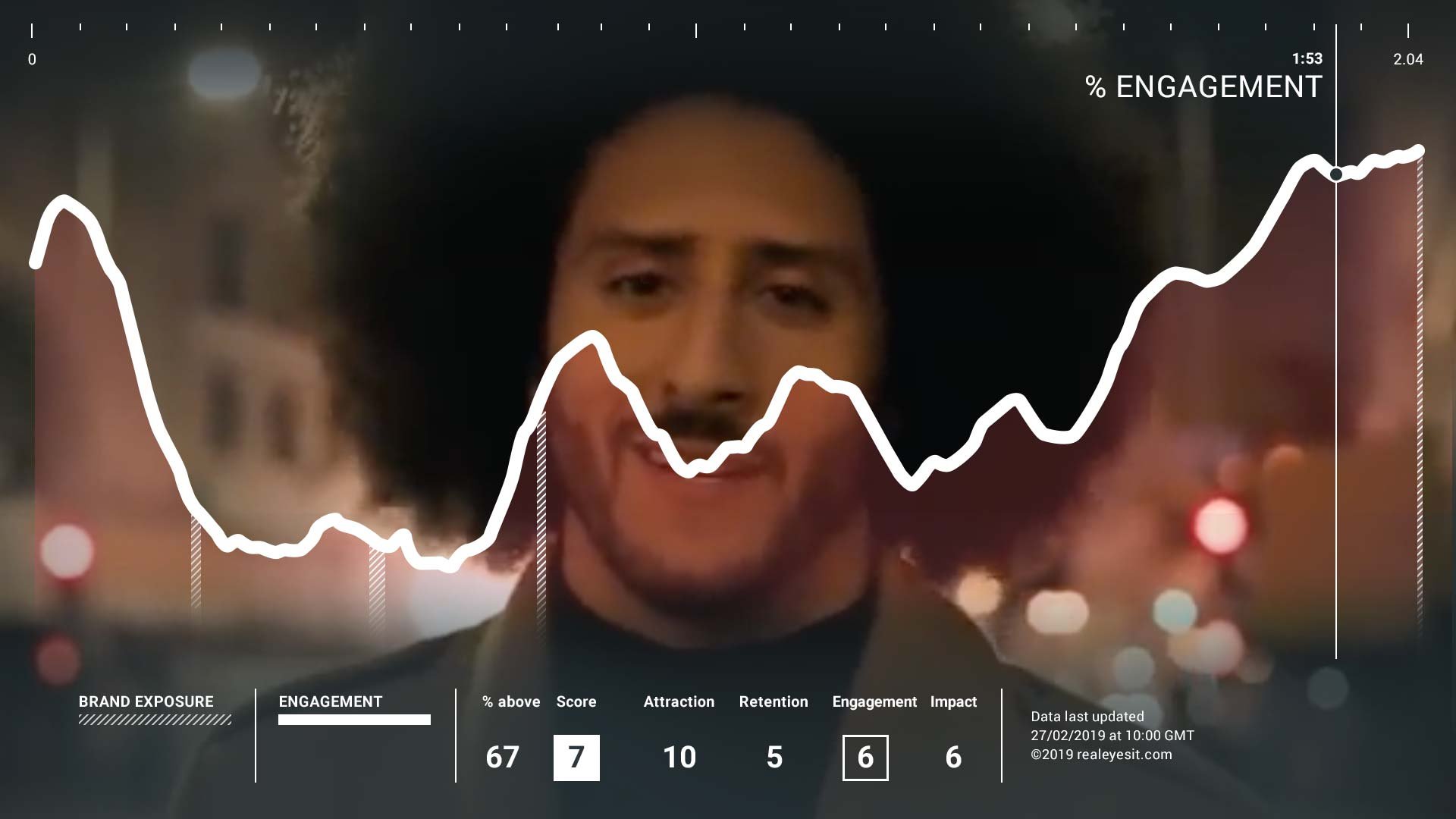
Dream Crazier
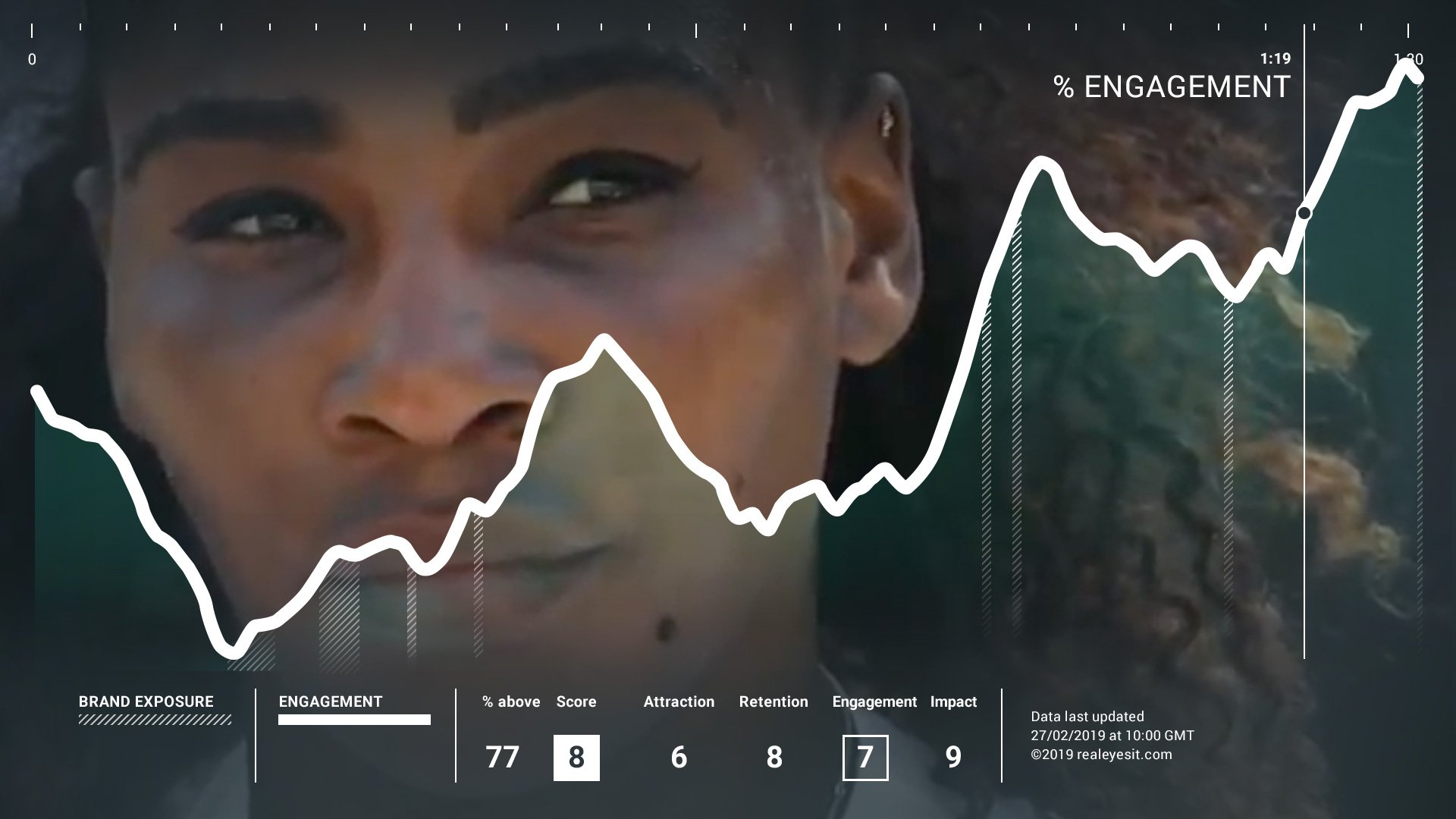
This is not surprising, as both ads ask a lot of its audience compared to more conventional ads. Not only do they seek audience attention but the nature of the content, and its political stance, challenges the audience to go from being passive to having a point of view.
But which attracted higher levels of engagement? Well, as you can see from the charts, “Dream Crazier” attracted higher levels of emotional engagement. In other words, people showed their emotions more visibly while watching.
Using Realeyes’ EmotionAll® score, which gives brands an instant snapshot of their video's performance, Dream Crazier attracted a score of 8/10, compared with 7/10 for “Dream Crazy”. This was largely driven by high levels of positive engagement in the the second half of this ad - Impact (9/10) - which builds to a crescendo at the end and peaks when the Nike logo is shown.
Both ads resonated more strongly with women. Among female viewers, “Dream Crazy” managed an EA score of 8/10, 83% higher than the average ad in Realeyes’ database of 20,000 ads. “Dream Crazier” also scored an 8/10 with women, but was 86% higher than the average.
However, among men, “Dream Crazier” was more popular, managing a score of 7/10, compared with Dream Crazy, which scored 6/10.
|
EmotionAll® Score - measuring facial expressions via webcam
|
|
| Dream Crazy, ft Colin Kaepernick | Dream Crazier, ft Serena Williams |
| 7/10 Overall | 8/10 Overall |
| 10/10 Attraction | 6/10 Attraction |
| 5/10 Retention | 8/10 Retention |
| 6/10 Engagement | 7/10 Engagement |
| 6/10 Impact | 9/10 Impact |
| 6/10 Male | 7/10 Male |
| (63% higher than other videos in Realeyes’ database) | (77% higher than other videos in Realeyes’ database) |
| 8/10 Female | 8/10 Female |
| (83% higher than other videos in Realeyes’ database) | (86% higher than other videos in Realeyes’ database) |
| Data last updated 27/02/2019 at 10:00 GMT | |
WHAT IS DRIVING ENGAGEMENT - MEN V WOMEN?
|
Engagement |
|
| Dream Crazy, ft Colin Kaepernick | Dream Crazier, ft Serena Williams |
 |
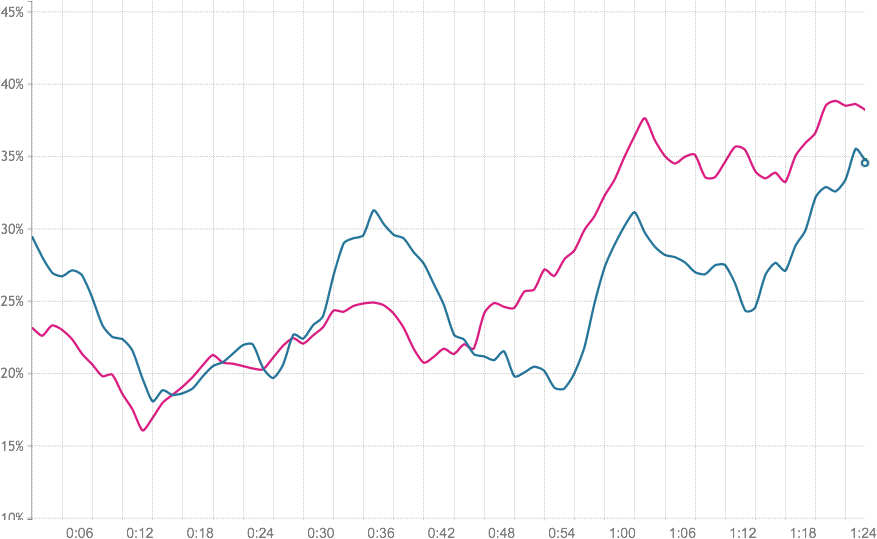 |
|
The ad is certainly full of contrasts, both in terms of audience response and the creative itself. By juxtaposing images - such as obesity to iron man, or ‘refugee’ to goalscorer - the ad plays with audience’s emotions, creating tension - particularly among men. This interplay asks the audience to be more contemplative than entertained. The continuous edits between ordinary people and sports stars is a similar technique used in Nike’s ‘Londoner’ campaign earlier in the year. Montages or fast edits are typically taxing on an audience, whereas these edits are held together with Kaepernick’s narration, reminiscent of 'Wear sunscreen' (“Advice, like youth, probably just wasted on the young”). When Kaepernick says something that sounds negative such as, "don't become the best" – negative peaks occur but they soon become positive when his narration resolves.
|
Male Significant Peak Engagement (0:31 - 0:36) Men appear to like the two scenes where passion is high bordering on physical aggression. “We’re hysterical…”. Men’s positive engagement peaks and female engagement at its lowest. Like women, Male engagement also increases when Serena is on screen, just not quite as much as women. Male engagement really dips when it talks about equal opportunity and playing with men. Male engagement hits peak at the end, with the reveal of the campaign Just Do it and the brand. Female Strong Trajectory Engagement (0:46 - 1:04) The build in soundtrack, the sequence of edits and the rhythm of the narrator’s repeat of “crazy”. Female engagement hits peak at the end, with the reveal of the campaign Just Do it and the brand. |
HOW DID PEOPLE FEEL?
Both ads use the interplay between negative and positive emotions to drive emotional engagement throughout.
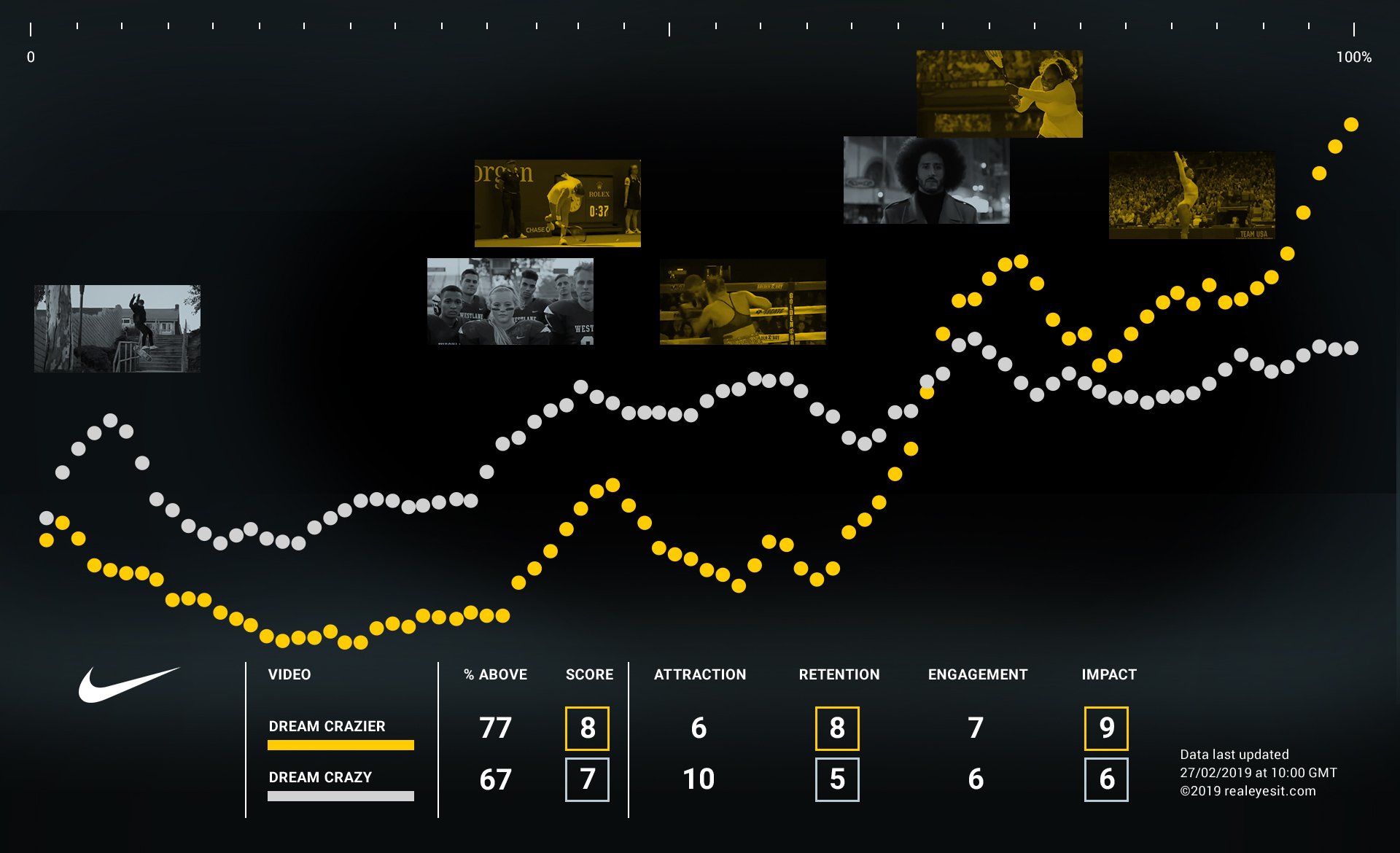
|
Positive vs Negative Emotion |
|
| Dream Crazy, ft Colin Kaepernick | Dream Crazier, ft Serena Williams |
|
The polarizing nature of the video creates an interplay between positive and negative emotions, resulting in a good overall engagement, especially towards the end. Male viewers had more tension between positive and negative emotions, while women largely contribute to the surge in engagement towards the end. There's significantly more tension within the responses from men, whereas the emotions from women show a significant trajectory of positive emotion. Perhaps men were having a harder time processing the topics within the ad?
|
With tears from the get-go, there’s significant negative emotion displayed from viewers. The narrative flips from a negative set-up from all of the barriers and prejudices that sportswomen face but the negative emotion drops once the tone switches to the positive narration and building soundtrack. Significantly negative or perhaps contemplative emotions. Positive emotion soars from 0:54 to the end. Negative peaks correlate with the narration as examples are given of how sportswomen can be described as “unhinged”, “there’s something wrong with us” or “hysterical”. Surprisingly perhaps men were felt more negative towards the first half of the video. |
|
Positivity |
|
| Dream Crazy, ft Colin Kaepernick | Dream Crazier, ft Serena Williams |
|
Women 24% more likely to smile at this ad than the average ad and 42% more likely to smile at the ad than men. |
The ad attracted higher-than-average smiles from women. Men were 40% less likely to smile than women and smiled 31% less than the average ad. |
|
Confusion |
|
| Dream Crazy, ft Colin Kaepernick | Dream Crazier, ft Serena Williams |
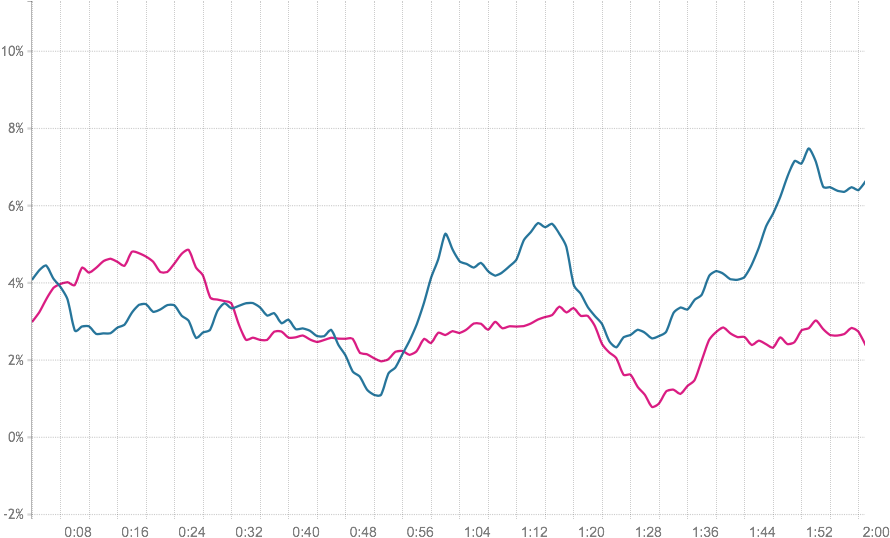 |
|
|
Confusion levels were not quite as high for Dream Crazy than Dream Crazier. They were slightly higher than average for men, particularly towards the end. and lower for women.
|
Men displayed significant confusion - 107% higher than average; whereas women were were also confused, 94% higher than avg. This may not be because viewers were confused by the content. This ad doesn’t set out to entertain in the traditional sense, the topic of gender politics in sport makes both genders engage, take note, consider, empathise with the seriousness of the topics raised; all of which generate a furrowing of the eyebrows that look like confusion or sadness |
|
Tonal Differences |
|
| Dream Crazy, ft Colin Kaepernick | Dream Crazier, ft Serena Williams |
|
The soundtrack, “We Move Lightly” by Dustin O’Halloran is powerful but melancholic throughout, whereas Dream Crazier uses an orchestral piece that builds to a crescendo, the use of this dynamic contributes to the level of Engagement.
|
There is a high level of positivity towards the second half of Dream Crazier, with an Impact score of 9/10. The audience is left with a positive feeling. The tone of both the narrator and the build in the music are significant contributors to this Impact, culminating with the brand reveal. Comparatively, the Colin Kaepernick ad uses similar edits, with similar copy but the delivery is more sombre, slower, melancholic even. The slo-mo of Serena’s face in Dream Crazier accelerates the upward trajectory of the Engagement trace, as does the edit of her smashing the ball which brings the ad to its climax. |
SENTIMENT - WHAT DID PEOPLE SAY ABOUT THE CONTENT
Realeyes also asked viewers to leave their thoughts on what they thought of the two ads. We then used AI to score each comment to see which ad attracted the more positive comments. Overall, “Dream Crazier” attracted a higher percentage of positive comments from viewers, while “Dream Crazy” proved a lot more polarising.
|
Positive Comments |
|
| Dream Crazy, ft Colin Kaepernick | Dream Crazier, ft Serena Williams |
|
Examples: “That was a really inspiring commercial. I think Nike is outstanding.” “This ad is soooo important right now to draw attention to the discrimination and denial of our rights at this point in time.”
|
Examples: “I love seeing amazing women succeeding at the things they set out to achieve. Makes me so hopeful for my daughter’s future.” “It was an incredibly inspirational video. As a woman myself, I love watching women succeed in fields that traditionally only men were allowed to succeed in.” “Powerful ad. I love showing all the obstacles in athletics that women have faced and overcome." |
|
Sentiment Score |
|
| Dream Crazy, ft Colin Kaepernick | Dream Crazier, ft Serena Williams |
|
+ 3.03 Women + 3.14 Men 70.9% left positive comments 5.6% were ambivalent or neutral 22.6% felt negatively towards the ad
|
+ 4.39 Women + 3.82 Men 79.8% left positive comments 13.5% were ambivalent or neutral 6.7% felt negatively towards the ad
|
|
Sentiment score (scale between -10 and +10, with 0 neutral) |
|
ATTENTION
Dream Crazy attracted slightly higher attention than Dream Crazier, possibly due to its more controversial content.
|
Attention Volume |
|
| Dream Crazy, ft Colin Kaepernick | Dream Crazier, ft Serena Williams |
|
The ad attracted higher-than-average levels of attention from both men and women. Altogether, 86% of viewers were attentive to the content.
|
The ad attracted slightly higher-than-average attention levels from both men and women. Altogether, 83.6% of viewers were attentive to the content. |
|
Measured using webcams to track body language and eye movements. Attention volume shows the average volume of attention respondents paid to the content. For example: A score of 50% means that throughout the video half of the viewers were attentive to the content on average. |
|
Conclusion
-
Emotional engagement higher for Dream Crazier: Dream Crazier scored higher than Dream Crazy, among both women and men. People were more engaged with the content, and the emotions they showed while watching were a lot more positive.
-
Comments less polarised: This is reflected in the viewer comments. People were more likely to leave positive comments and the overall sentiment of these comments was a lot higher, particularly among women. They were also less polarised. While 22.6% of comments left about Dream Crazy were negative and only 5.6% neutral, Dream Crazier attracted far less criticism, with only 6.7% negative and 13.5% neutral.
-
Serena reaction more positive: The reaction to Serena Williams is also interesting. Dream Crazy was released around the time of Williams’ controversial outburst at the US Open Final last year, which may have affected the way people reacted to her. In fact, the negative emotional responses to her on screen were even more pronounced than when Kaepernick was on screen. However, with Dream Crazy, the response to her is a lot more positive.
-
Lessons learned: Both ads employ similar techniques - the negative set-up to the positive resolve and the use of historical sports footage - but there may have been some learnings following the Colin Kaepernick ad that triggered some differences in approach.
These are:
-
30 second shorter duration
-
More positive soundtrack
-
More positive delivery of narration
-
Higher frequency of brand exposure
